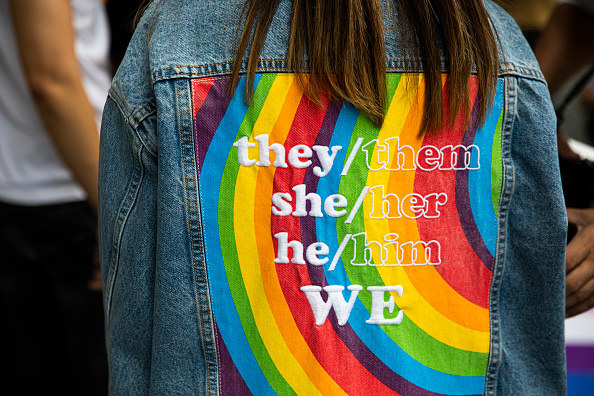
This is an excerpt from Quibbles & Bits, the BuzzFeed News copy desk’s newsletter. Sign up below to nerd out about language and style with us once a month!
In March 2021, Halsey wrote in an Instagram story, "The inclusion of ‘they,' in addition to ‘she,' feels most authentic to me. If you know me at all you know what it means to me to express this outwardly.”
Months later, Allure published a profile of Halsey, which inspired the singer to tweet that they would no longer do press; among her reasons was that the cover story uniformly referred to the artist with she/her pronouns.
“Your writer made a focal point my pronouns in my cover story and you guys deliberately disrespected them by not using them in the article,” Halsey tweeted.
The day after the profile went up, the publication issued a mea culpa and edited the piece to use both pronouns interchangeably. In the story, which touches on Halsey’s gender fluidity, the artist says, “The whole thing to remember about pronouns and identities is that they’re not meant for other people. They’re meant for you to help better understand yourself.”
It’s important to respect the variance of those who use multiple pronouns (like she/they, he/they) and refer to them accordingly. Halsey’s reaction, and insistence of both pronouns being used, is not necessarily a universal one; others who use he/they or she/they may be comfortable with an either/or attribution in a story. If you’re unsure, always ask!
It’s not necessarily confusing to cite someone as both she and they (or to refer to someone with the singular they) if they’re the only person interviewed in a story. And claiming the singular they will confuse readers is a common excuse that some style guides point to, but that’s becoming rarer as time goes on; most readers generally don’t notice it or think twice.
The New York Times is trolling me personally at this point.
Pronouns are an unassuming part of speech, but they’re also an elemental part of identity and far from inconsequential. It’s crucial for anyone who helps assemble a story (including the writer, editor, and copy editor) to ensure that the language matches someone’s identity. Here is the BuzzFeed News copy desk’s guidance for pronouns:
Bob Dole, who uses he/him pronouns, died at the age of 98 on Sunday.
Writing about someone like Halsey with multiple, interchangeable pronouns is one thing, but plenty of people use neopronouns (ze/hir/hirs; ze/zir/zirs; e/em/eir; xe/xem/xyr; etc.), which are less traditional and which a reader might not recognize or understand to be a pronoun.
For stories in which these people are featured or interviewed, the BuzzFeed copy desk might advise editors to explicitly state that the person uses neopronouns before the story employs them, reword subsequent references to the person, or repeat their name. But avoiding someone’s pronouns isn’t a perfect approach; even the typically conservative Associated Press Stylebook notes in its “pronouns” entry that writing around the singular they “may make people feel censored or invisible.”
In 2017, AP wrote that the singular they is “acceptable in limited cases” as a singular or gender-neutral reference, although “rewording usually is possible and always is preferable,” and noted as recently as 2020 that it’s “unfamiliar to many readers,” which is definitely no longer the case.
Today, AP suggests using “they/them/their as a way of accurately describing and representing a person who uses those pronouns for themself” but still notes that it "may be confusing to some readers and amount to a roadblock that stops them from reading further." It also advises that writers “not use neopronouns such as xe or zim; they are rarely used and are unrecognizable as words to general audiences.” We think you can still use neopronouns in a story, with an explanation if you feel it’s needed.

In his book What’s Your Pronoun? Beyond He and She, linguist Dennis Baron writes that the pursuit of a singular nongendered pronoun dates back centuries, with dozens of pronouns being coined to fill the gap (including ze, zhe, hir, hem, han, hizzer, hiser, himmer, thon), each with its own origin.
“The fact that gender-neutral pronouns and nonbinary pronouns are invented over and over again, often by people completely unaware of previous attempts to find the missing word, suggests that speakers of English do feel that a word is missing from the set of personal pronouns,” he writes.
Baron also notes that this debate over how to use a singular pronoun outside the gender binary has arisen in some other dialects, such as a French dictionary coining a gender-neutral pronoun, Swedes using the gender-nonspecific pronoun hen, and Spanish speakers drawing attention to the gendered nature of the language’s nouns and articles.
He/him pronouns were historically used as gender-neutral pronouns in legislation and literature, which was, at best, inaccurate and fraught; during the women’s suffrage movement, Susan B. Anthony noted that despite the generic masculine pronouns in criminal laws, it was understood that they still applied to women. But if lawmakers insist on following the letter of the law, Anthony said in an 1873 address, then the corollary would suggest that women should not pay taxes or otherwise be beholden to the legal system.
Baron points to other times throughout US history when a gender-neutral pronoun was sought, including in 1894 when a newspaper needed to refer generically to lawmakers after three women were elected to the Colorado legislature. In 1920, the Sacramento Bee published a headline reading “‘Hir’ Will Be the Bee’s Word for ‘He or She.’” (The paper’s reporters only sporadically used hir in the following years into the 1940s, Baron writes, but it has been revived as a nonbinary pronoun in the 21st century.)
Among the historical uses of the singular they that Baron cites, it’s clear that pushback against it as a singular pronoun is nothing new — even though, as Baron writes, it’s been “good, idiomatic English for 700 years.” President Calvin Coolidge noted in 1926 that no voter should “abdicate their sovereign right of self-government” by failing to vote; his use of the singular they was called by one newspaper a “technically lawless act.”
The 14th edition of the Chicago Manual of Style initially advised writers to use the singular they, noting that it’d been used by Jane Austen, William Shakespeare, and others for centuries. In the 16th edition, Chicago wrote, “Many people substitute the plural they and their for the singular he or she. Although they and their have become common in informal usage, neither is considered acceptable in formal writing.” The latest edition allows for the singular they and other gender-neutral variations and notes that “any such preference should generally be respected.”
if you can pretend that a groundhog is predicting the weather for the next six weeks, you can use they/them for a single person
But whatever the prescriptivists say, mainstream adoption is what matters the most. “What’s different about pronoun discussions today is that more and more people are taking the gender debate away from the medics and grammarians and making it their own,” Baron writes.
Plenty of resources out there can help reporters more responsibly cover issues of gender identity. We often turn to the comprehensive Trans Journalists Association style guide, as well as the GLAAD media reference guide and the Radical Copyeditor’s Style Guide for Writing About Transgender People.
What trans style guides do you use? What did we miss here? Feel free to email us bfstyleguide@buzzfeed.com or tag us @styleguide.
Thumbnail credit (denim jacket): Lauren DeCicca/Getty Images.
